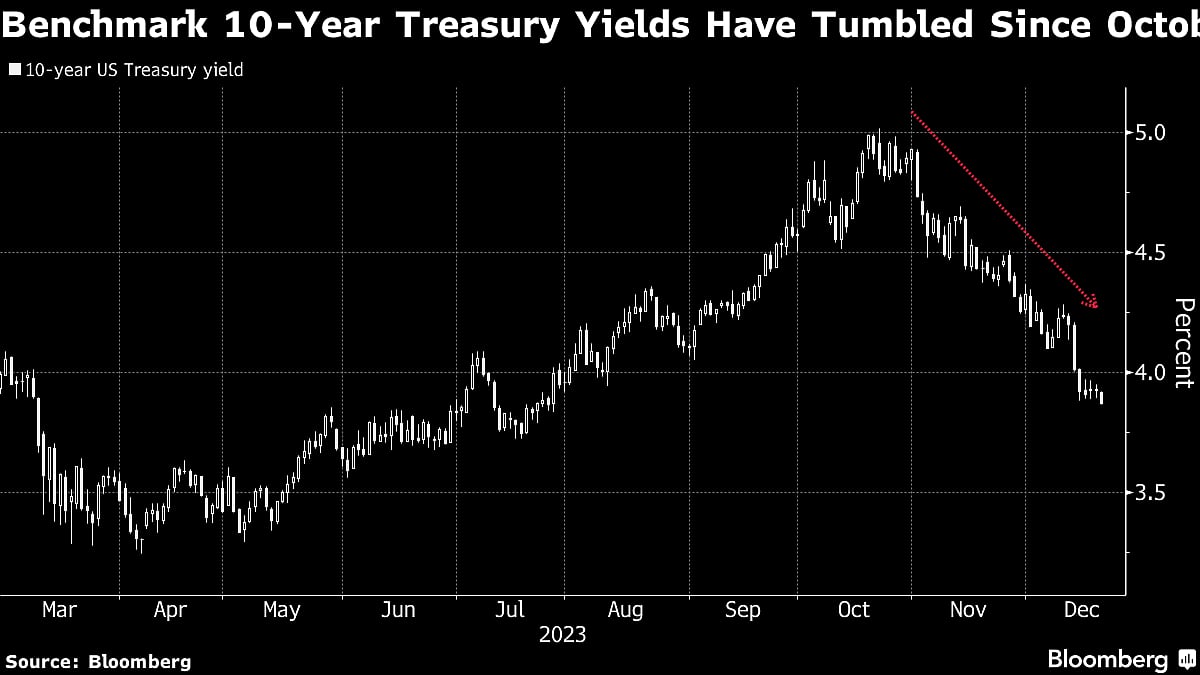Treasuries Rally With Global Bonds As Traders Lift Rate-Cut Bets
Germany’s 10-year yield fell below 2% for the first time in nine months, as worsening euro-area economic data and slowing inflation underscore the need for interest-rate cuts next year.

(Bloomberg) -- Treasuries rallied along with global bonds, sending benchmark yields to multi-month lows, as traders bet the world is entering a new, disinflationary period by wagering on more interest-rate cuts next year.
US 10-year Treasury yields — the global risk-free rate — slid to the lowest since July, down well over a percentage point from a 16-year high in October of 5.02% The similar-maturity German Bund yield plunged below 2% and the rate on equivalent gilts slumped to the lowest since April. Wednesday’s move was sparked by a softer-than-expected UK inflation figure. Yields the Fed-policy sensitive 2-year Treasury note was down 10 basis points late in the session.
The inflation data encouraged investors to lean further into bets for aggressive monetary-policy easing next year by the Federal Reserve and other major central banks with price pressures seemingly on a course to reach their targets. Swaps traders have ramped back up the amount of cuts to come from the US central bank in 2024 to about 150 basis points — equivalent to six quarter-point rate reductions.
Our view is “that the Fed does cut a few times next year, that growth does slow down – sort of 1% — which will look and feel pretty recessionary for some people,” Tom Porcelli, chief US economist at PGIM Fixed Income, said on Bloomberg television. “When I think about the next year or two, I don’t really see any meaningful catalyst to sort of break us out of what could be a really sluggish growth backdrop.”

Rates were lower across Treasury maturities on Wednesday, with declines in short-tenor debt leading the decline. The 10-year note hovered around 4.34%, down about 10 basis points at 4:30 p.m. New York time.
Read more: Fed’s Harker Says Rates Should Move Down But Not Immediately
Long-term US yields pared declines after the Treasury’s auction of $13 billion of 20-year bonds received tepid demand. The sale resulted in a so-called tail — or yield premium over where the securities were trading just before the auction bidding was complete — of around 1.5 basis points.
“It’s a mediocre to maybe a little bit on the weaker side of an auction,” Ira Jersey, chief US interest-rate strategist at Bloomberg Intelligence, said on Bloomberg television. “This one came with weaker demand” with it having “the lowest bid-to-cover of the last several months. Dealers had to mop up some of the excess.””
Attention will next turn to a GDP revision on Thursday and personal-spending data on Friday, including the Fed’s preferred inflation gauge, known as PCE.
In the UK, consumer prices rose 3.9% in November from a year earlier, down from 4.6% in the previous month, the Office for National Statistics said on Wednesday. That compares with a more-than four-decade high rate above 11% reached last year.
The softer inflation data prompted Goldman Sachs to bring forward its expectation for the first BOE rate cut to May from June previously.
Expectations for the ECB are more aggressive, with 162 basis points priced in, as worsening euro-area economic data and slowing inflation underscore the need for rate cuts next year.
A gauge of German business expectations released earlier this week surprisingly worsened in December, while euro-area PMIs contracted for a seventh month. Analysts surveyed by Bloomberg forecast the region to enter its first recession since the pandemic.
“The market is due a bit of a correction, but given the data in Europe, the ECB should be the first to reverse hikes, and thereby medium-term yields will go lower,” said Charles Diebel, head of fixed income at Mediolanum International Funds in Dublin.
--With assistance from Anchalee Worrachate, Naomi Tajitsu, Carter Johnson and Zoe Schneeweiss.
(Updates rates throughout.)
More stories like this are available on bloomberg.com
©2023 Bloomberg L.P.